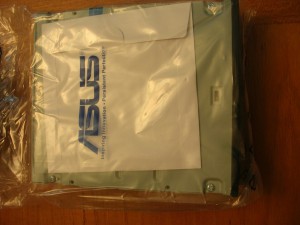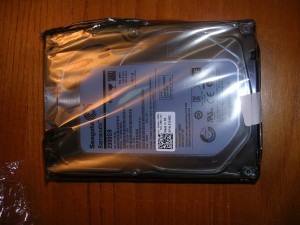Optical Drive
Alright, for this next post in the Antec Custom Build series, I am analyzing the various pieces of hardware which I installed in and around the front loaded HDD cages. Foremost, I went with an ASUS 24x DVD-RW Internal Optical Drive. Now an optical drive may be considered old tech at this point, but I had some valid reasons for including it in my gaming rig. First, it is designed for both CD-R/RW and DVD-R/RW. As such, the first use for this optical drive was for the installation of my operating system, Windows 7 Home Premium, and various drivers. Next, the drive has come in handy for installing popular PC games such as Starcraft II: Wings of Liberty and Batman: Arkham City, though more and more games are becoming Steam compatible. Of course I also prefer having a hard copy of these games and fully enjoy the box art for each game and the visual appeal of a bookshelf with my games lined up from one end to the other. Finally, though I do not use the drive for these functions often, I am also able to burn files or music to CDs or write movies to a DVD.
Hard Disk Drive (HDD)
As an essential component of a computer, the HDD serves as a mass data storage device, often ranging from 250 gigabytes (GB) to 4 terabytes (TB) in size for casual users. For purposes of comparison, a single terabyte has a capacity of 1,000 gigabytes while a gigabyte has the capacity of 1,000 megabytes. Used for storing, and subsequently retrieving, information, each HDD is often utilized for storing program files, music, movies, pictures, and documents. Of course, the capacity of a purchased HDD is not always the full advertised amount due to the use of some of this capacity by the internal file system, operating system, and/or recovery software.
Within my system, I installed the Seagate Barracuda 2 TB Internal Hard Drive. Prior to building this computer, I originally went with a Western Digital 750 GB External Hard Drive for storing all of my back-up documents along with my music, movie, and picture files. Unfortunately, that particular drive crashed after roughly four years of use, taking a good portion of those files with it. Therefore, after doing some extensive hard drive reviews, and taking into account the opinions of current owners, I decided to go with this Seagate Barracuda drive which has been touted as not only cheaper than a lot of equivalent drives, but more reliable with proven performance.
Foremost, with 7,200 revolutions per minute (RPM), or 120 Hz, this hard drive operates effectively and efficiently to read data from and write data to the hard drive’s platter(s) as it rotates past the read-and-write heads. I consider this to be a useful speed as it balances both energy efficiency and storage capacity. This can be compared to more high-performance oriented drives, which rotate at around 10,000 to 15,000 rpm, associated with higher data transfer rates and lower average access times. As such, when deciding between the more standard 7,200 rpm hard drive and the faster 10,000 rpm to 15,000 rpm hard drives, there are a few tradeoffs. While reliability may be comparable, lower noise levels and a reduced cost are associated with the 7,200 rpm hard drives while the better performance is associated with the 10,000 rpm to 15,000 rpm hard drives. As it is associated with the data transfer rate, you cannot go wrong with the SATA 6 Gb/s architecture which, with a data transfer rate of 6 gigabytes per second, improves upon the previous generation of SATA. When connecting the HDD to the motherboard, I went with the OKGEAR 18” SATA 6 Gb/s Cable which, for connection purposes, was straight to right angle and also backwards compatible with 3 Gb/s and 1.5 Gb/s if I ever needed that functionality.
Solid State Drive (SSD)
Among secondary storage devices, including both HDDs and optical drives, SSDs are now taking the forefront. Specifically, though HDDs continue to serve as an effective and reliable medium for storing information, with reasonable access speeds and high storage capacity, SSDs have come onto the technology scene with numerous improvements. Compared to HDDs, SSDs are built upon integrated circuit, or microchip, architecture which is used to store data persistently, or over a long duration. This solid-state architecture is based upon circuits built from solid materials whereby charge carrying electrons are confined within these materials. Solid-state devices often consist of transistors, microchips, and random access memory (RAM). Specifically, with NAND-based flash memory, a type of non-volatile memory, data is retained regardless of the loss of power, such as in the case of computer shutdown.
Therefore, since there are no moving components, compared to the read-and-write heads of the HDDs, SSDs produce no noise or vibration and are substantially more durable due to the lack of moving parts. Additionally, SSDs have lower access time and latency and are more resistant to physical shock and the effects of magnetism. Unfortunately, when compared with an HDD, though the SSD has a vastly improved operating system boot time and increased application and/or file opening speed, due to the aforementioned reduced seek/access time and latency, HDDs still retain an edge on the market in terms of their quicker write times, lower cost per gigabyte, and overall data storage capacity.
For my computer, I went with the Samsung 840 Pro Series 256 GB Solid State Drive. The SSD was installed on the bottom of the Antec computer case in an area designated for a 2.5” SSD. This SSD seems to be both highly regarded and well-reviewed. As such, while there were a few quality SSDs to choose from, my friend personally recommended the purchase of this Samsung SSD, to go along with the 2 TB hard drive, for the specific purpose of reducing my boot times and quick (near instantaneous) launching of applications, especially games. I specifically decided on the 256 GB, versus the 128 GB SSD, to allow for the installation of the Windows 7 operating system, and numerous Steam and PC games, in order to achieve the improved boot and application launch times. In fact, my PC boots to the desktop in an average of 20 seconds with a range of roughly 18 – 22 seconds. I was also pretty satisfied with the Samsung brand name and the idea of a five year warranty. The SSD is definitely a performance enhancing device you’ll want to include in your set-up.





